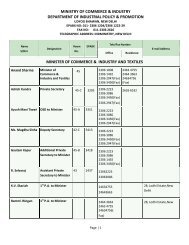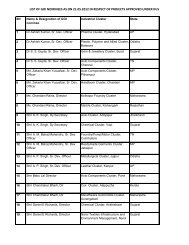fdi in india and its growth linkages - Department Of Industrial Policy ...
fdi in india and its growth linkages - Department Of Industrial Policy ...
fdi in india and its growth linkages - Department Of Industrial Policy ...
Create successful ePaper yourself
Turn your PDF publications into a flip-book with our unique Google optimized e-Paper software.
FDI IN INDIA AND ITS GROWTH LINKAGES<br />
mach<strong>in</strong>ery (292), 24 per cent <strong>in</strong> wear<strong>in</strong>g apparel (181), 20 per cent <strong>in</strong> basic iron <strong>and</strong> steel (271), <strong>and</strong> 18 per cent <strong>in</strong><br />
electrical equipment (319). Export <strong>in</strong>tensity is relatively low <strong>in</strong> sectors such as electricity distribution <strong>and</strong> control<br />
apparatus (312), motor vehicles (341), non-metallic m<strong>in</strong>eral products (269), medical appliances (331), dairy products<br />
(152), transport equipment (359), ref<strong>in</strong>ed petroleum products (232), footwear (192), tobacco products (160), domestic<br />
appliance (293) <strong>and</strong> radio <strong>and</strong> TV receivers (323).<br />
Net foreign exchange (forex) earn<strong>in</strong>gs of FDI as well as domestic firms are negative. 13 The net forex deficit amounts to<br />
2,794 billion, with FDI firms account<strong>in</strong>g for Rs. 311 billion (11 per cent) of this deficit. Some sectors have a surplus on<br />
net forex earn<strong>in</strong>gs; these <strong>in</strong>clude chemical products (242), build<strong>in</strong>g <strong>and</strong> construction parts (452), m<strong>in</strong><strong>in</strong>g of iron ores<br />
(131), textiles (171) <strong>and</strong> software publish<strong>in</strong>g, consultancy <strong>and</strong> supply (722). Manufacture of ref<strong>in</strong>ed petroleum products<br />
(232) is the largest forex deficit-<strong>in</strong>curr<strong>in</strong>g sector. Other such sectors <strong>in</strong>clude basic precious <strong>and</strong> non-ferrous metals (272),<br />
iron <strong>and</strong> steel (271) <strong>and</strong> basic chemicals (241).<br />
6.3.6 Labour Wage Intensity<br />
An important issue <strong>in</strong> assess<strong>in</strong>g the impact of FDI firms is their ability to generate employment <strong>and</strong> provide returns to<br />
labour <strong>in</strong> these firms. Employee cost can be taken as a proxy for payment to workers. We def<strong>in</strong>e “labour wage <strong>in</strong>tensity”<br />
as the employee cost <strong>in</strong>curred per unit of net fixed capital.<br />
The ratio of employee cost to net fixed capital turns out to be 19 paise per rupee for FDI firms (Table 6.37); the<br />
correspond<strong>in</strong>g ratio is 15 paise for domestic firms. Hence, the labour wage <strong>in</strong>tensity <strong>in</strong> FDI firms is about 25 per cent<br />
higher than <strong>in</strong> domestic firms. Certa<strong>in</strong> sectors have relatively high labour wage <strong>in</strong>tensity for FDI firms. The software<br />
development <strong>and</strong> publish<strong>in</strong>g sector (722) provides the highest returns to <strong>its</strong> employees <strong>in</strong> terms of per unit of their net<br />
fixed capital, followed by footwear (192), medical appliances (331) <strong>and</strong> electricity distribution <strong>and</strong> equipment (312),<br />
among others. The correspond<strong>in</strong>g values for domestic firms are relatively low <strong>in</strong> all these sectors.<br />
6.3.7 Output to Capital Ratio<br />
Output to capital ratio is an <strong>in</strong>dicator of production per unit of capital. Some sectors produce more output per unit of<br />
capital, while others produce less. In our database, the FDI firms produce Rs. 3.55 worth of output per rupee of net fixed<br />
capital, compared with Rs. 2.92 for domestic firms (Table 6.37). The output to capital ratio for the FDI firms is relatively<br />
high for sectors such as medical appliances <strong>and</strong> <strong>in</strong>struments (331), electricity distribution <strong>and</strong> control apparatus (312),<br />
ref<strong>in</strong>ed petroleum products (232), m<strong>in</strong><strong>in</strong>g of iron ores (131) <strong>and</strong> transport equipment (359), among others. The<br />
correspond<strong>in</strong>g values for domestic firms are relatively low <strong>in</strong> all these sectors.<br />
6.3.8 Plant-Level Average Labour <strong>and</strong> Capital Intensity<br />
Class-3 cities have relatively higher scale, market capitalisation, value-added, wages paid <strong>and</strong> output per plant vis-à-vis<br />
medium <strong>and</strong> large cities. Information on the skill composition of workers employed <strong>in</strong> manufactur<strong>in</strong>g plants is not<br />
available (Tables 6.38 to 6.43). Net fixed capital per plant is Rs. 81 crore <strong>in</strong> Class-3 cities <strong>and</strong> Rs. 57 crore <strong>in</strong> others.<br />
Market capitalisation per plant is Rs. 466 crore <strong>in</strong> Class-3 cities <strong>and</strong> Rs. 381 crore <strong>in</strong> others. Value-added per plant is<br />
Rs. 50 crore <strong>in</strong> Class-3 cities <strong>and</strong> Rs. 38 crore <strong>in</strong> others. Employee cost per plant is Rs. 14 crore <strong>in</strong> Class-3 cities <strong>and</strong> Rs.<br />
12 crore <strong>in</strong> others. Output per plant is Rs. 286 crore <strong>in</strong> Class-3 cities <strong>and</strong> Rs. 206 crore <strong>in</strong> others. Employment per plant<br />
is 2,058 <strong>in</strong> Class-3 cities <strong>and</strong> 1,243 <strong>in</strong> other cities.<br />
13.Net forex earn<strong>in</strong>g is def<strong>in</strong>ed as the difference between gross earn<strong>in</strong>gs <strong>in</strong> forex m<strong>in</strong>us gross expenses <strong>in</strong> forex. Gross forex earn<strong>in</strong>gs <strong>in</strong>clude exports; <strong>in</strong>terest,<br />
dividend <strong>and</strong> other earn<strong>in</strong>gs. Gross forex expenses <strong>in</strong>clude imports of <strong>in</strong>termediate as well as capital goods; royalty <strong>and</strong> technical fees paid; foreign travel;<br />
<strong>in</strong>terest, <strong>and</strong> dividend <strong>and</strong> other expenses.<br />
66












